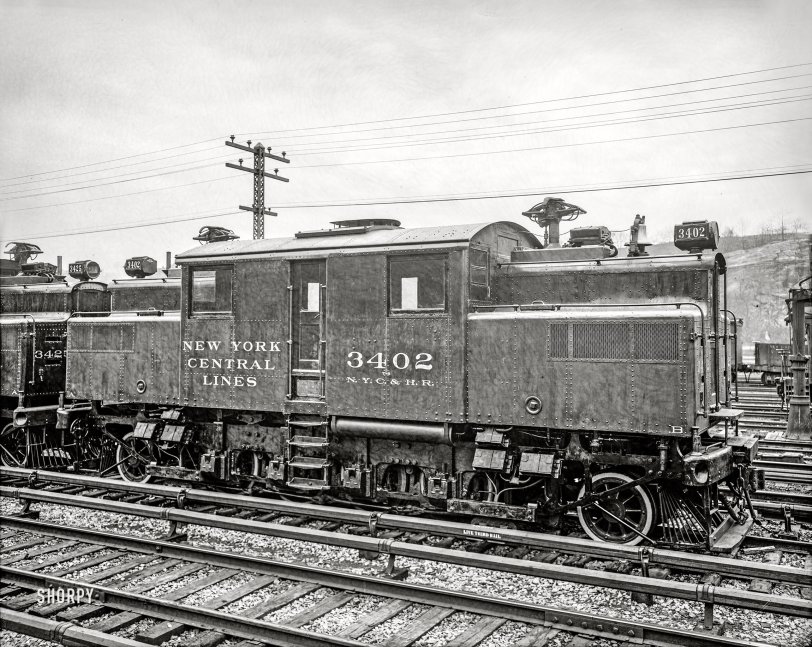


Framed or unframed, desk size to sofa size, printed by us in Arizona and Alabama since 2007. Explore now.
Shorpy is funded by you. Patreon contributors get an ad-free experience.
Learn more.

- What a headache!
- Baldwin 62303
- Baldwin VO-1000
- Cold
- No expense spared
- Tough Guys
- Lost in Toyland
- And without gloves
- If I were a blindfolded time traveler
- Smoke Consumer Also Cooks
- Oh that stove!
- Possibly still there?
- What?!?
- $100 Reward
- Freeze Frame
- Texas Flyer wanted
- Just a Year Too Soon
- WWII -- Replacing men with women at the railroad crossing.
- Yes, Icing
- You kids drive me nuts!
- NOT An Easy Job
- I wonder
- Just add window boxes
- Icing Platform?
- Indiana Harbor Belt abides
- Freezing haze
- Corrections (for those who care)
- C&NW at Nelson
- Fallen Flags
- A dangerous job made worse
Print Emporium
Live Third Rail: 1907

Circa 1907. "Electric locomotive, New York Central & Hudson River R.R." 8x10 inch dry plate glass negative, Detroit Publishing Company. View full size.
Bad retouching? Developer?
All the darker areas of the picture are showing mottling which happens when the developer is weak or the rinse bath is dirty. There are also a lot of brush marks from some type of retouching that was done in the past. Most of which was probably not visible in smaller prints.
[This is not a print. It's an artifact of the way the emulsion was applied to the glass plate. - Dave]
The baby pantographs
at each end of the cab picked up the current through long gaps in the third rail. Complicated switchwork would be one place they would come into play. The pictures I’ve seen show a rigid rail mounted close above the locomotive roof.
Shoes
A pair of underrunning third rail shoes are peeking out directly under "LIVE THIRD RAIL". They are shaped like paddles, hinged from the horizontal wooden beam, and sprung upward. There is another pair of shoes at the other "A" end of the locomotive, giving quadruple redundancy, and ensuring that at least one pair of shoes can contact the third rail across most gaps. However, "double slip" switches (see Wikipedia, essentially four switches intertwined in one unit) can leave a big enough gap in the third rail to strand an engine if it stops at the precise wrong spot. In this case, there is further redundancy provided by the two tiny pantographs on the roof that can contact a short section of overhead conductor above problematic switches. The relay boxes above the wooden beam ensure that the shoes exposed on the side of the engine away from the third rail are not hot. The entire system is a work of genius, and still in use where exposed voltage is a concern. The main alternative is fenced right of way and discipline.
Long-lived class S-2 Electric Loco
The prototype for this class, S-2, was the number 6000, class S-1:
https://en.wikipedia.org/wiki/New_York_Central_S-Motor
34 units followed, in class S-2, which developed roughly 2200HP, very powerful for its time. All of these engines were built in response to New York City's passing a law forbidding steam engines within the city, because sparks from one started a fire.
Some of these engines lasted until the early 70s, right after the New York Central and Pennsylvania RR's merger.
The prototype, number 6000, still exists, but is in bad shape:
https://www.trains.com/trn/news-reviews/news-wire/museum-works-to-save-t...
If the shoe fits ...
slide it. For all those who waited for the whole picture - literally and figuratively - after seeing the Detroit Tunnel shot, here you are.
These little guys proved remarkably durable - running well into the mid 20th century - but while the 3rd rail technology itself would be replicated, the engines themselves would not: later installations in Detroit and Cleveland would use different designs. The S-motors would remain New York City domiciled ... at least in the 1:1 world

























On Shorpy:
Today’s Top 5